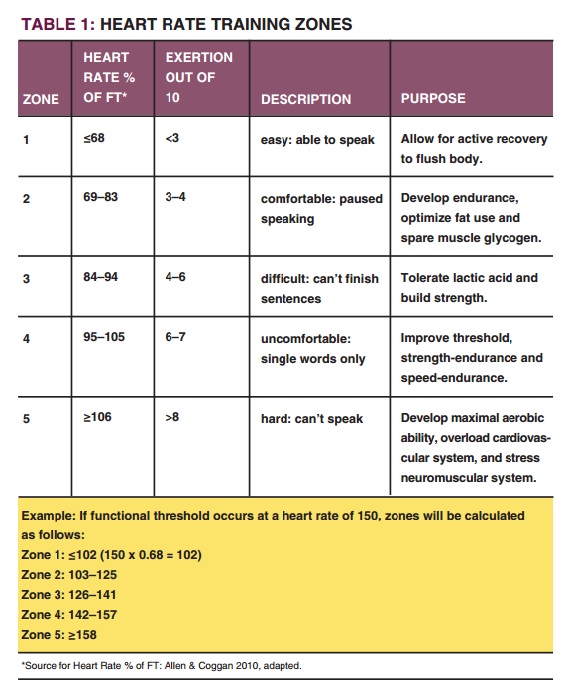
Unlocking the Potential of Heart Rate Monitors
Thanks to the fitness technology craze, heart rate monitors have become more than just something cyclists throw on before a race. These monitors are powerful tools that can help us assess cardiovascular health, measure exercise intensity, train the body to become fuel-efficient, improve fitness and performance, and avoid overtraining syndrome.
But once we start collecting all of this data, what should we do with it? This four-step guide will take the guesswork out of customized client programming.
Step 1: Get a Baseline
Start with a Functional Threshold test. Far better than general formulas of heart rate maximum or heart rate reserve, FT is meaningful for clients at a personal level. FT is great for two reasons: It’s the metabolic “fork in the road” between aerobic and anaerobic pathways, and you can find it with a simple talk test. Here’s how:
- Using traditional cardio equipment, start your clients at an easy intensity (exertion 3 out of 10).
- Each minute, increase intensity (speed, incline, resistance or power).
- At the end of each minute:
- Note heart rate and perceived exertion level.
- Have clients repeat these sentences: “A is for Apple. B is for Boy. C is for Cat,”and so on.
- Ask if they can handle another stage.
- Record heart rate at the following points:
- VT1: Ventilatory Threshold 1, reached when clients have to take deep, forced breaths after a sentence (e.g., “A is for Apple”)
- FT: reached when clients have to take a breath after a word or syllable (e.g., after “A” or “is for”)
- peak: the highest heart rate measured during the test
- When clients don’t want another stage, reduce the intensity to the starting level for cool-down.
Step 2: Create Training Zones
Now that you have identified the FT, you can create training zones that will line up to substrate use and metabolic demand during exercise. I recommend the Zone structure in Table 1.
Step 3: Build Training Plans
Optimal weightlifting programs encourage clients to work all body parts in all planes. Likewise, for good conditioning, clients should challenge their heart and lungs in all zones; this teaches the body to become proficient with all substrates, muscle fibers and levels of exertion.
Fortunately, FT test results can help you structure intervals and circuits for optimal balance in all training zones. For instance, if VT1 falls in Zone 1 or Zone 2, clients need to focus first on establishing their aerobic base. This means that more of their workouts should include lower-intensity efforts rather than high-intensity ones—say, 60%–80% of their time in Zones 1, 2 and 3, versus 20%–40% in Zones 4 and higher. If VT1 falls in Zone 3, clients can increase their threshold with high-intensity work—say, 50%–60% of their time in Zones 2 and 3, versus 40%–50% in Zones 4 and higher.
Reach High
We need high-intensity exercise to push limits, stress the body and improve cardiovascular function. But high intensity is hard—it’s supposed to be—and often we don’t push hard enough. Heart rate zones clearly show whether your clients are working at the correct intensity.
Get Low
Low-intensity zones improve capillary density, mitochondrial production of ATP (adenosine triphosphate) and oxygen capacity. They also teach the body to use fat as a fuel source and to spare muscle glycogen. Further, these zones are great for teaching proper breathing, technique and body mechanics, and for recovering from hard efforts.
Include Rest
Speaking of recovery, heart rate can also help determine time of recovery. For instance, after a high-intensity interval, clients can rest until their heart rate drops to low Zone 2 or high Zone 1. Once heart rate reaches this level, clients are ready for the next interval. This way you are training by body response, not by the clock.
Work Steady
Short efforts of 20–30 seconds and medium efforts of 60–120 seconds have been shown to be effective ways to train, no matter the level of intensity. But don’t shy away from longer steady-state efforts. Including efforts of 2 minutes or longer (even up to 20 minutes!) can boost strength and speed endurance, and can better teach the body to tolerate lactic acid.
Progress
When designing programs, mix up intervals to keep things fresh. But avoid making each workout so different that your clients can’t adapt. Ideally, you want to repeat circuits and intervals so you can easily see improvement toward goals. The best approach is to stick to a theme for 4-week phases, as shown in Table 2.
Heart rate training programs don’t require a massive amount of time. Just 30 minutes a day, 3 days a week can create a fast, optimal effect.
In addition, heart rate training doesn’t have to use traditional cardio machines. Mix in circuits with major pillars of movement. Just remember that heart rate can be affected by body position and load, so identify different average and peak heart rates for different exercises (like squats, push-ups or pull-ups) and use a variety as you build your programs and progressions.
Step 4: Analyze the Data
Once workouts have begun, it’s time to analyze workout data. Watch average and peak heart rates. Compare numbers with objective data such as speed, time or workload (e.g., incline, weight, reps and sets) and time to recovery. Also consider subjective data such as perceived exertion to keep your clients mindful about their workouts.
Compare numbers across similar workouts. In a few weeks, your clients should be able to complete more work at the same heart rate, or the same work at lower heart rates. This shows clients that they have become efficient and are ready to progress.
Monitor acute (short-term or 1 week) and chronic (long-term or 4–6 weeks) training loads with daily, weekly and monthly dashboards and heart rate distribution charts. This ensures that your clients are spending the appropriate amount of time in each training zone and that the progressive-overload principle is being applied rationally.
From Numbers to Knowledge
When it comes to technology, you can get lost in the numbers. But when you keep things simple, you can develop truly effective solutions for your clients and your business. By performing baseline tests, understanding how to interpret the resulting numbers and then using them to adjust plans, you can make heart rate data a powerful tool.
Analyzing heart rate data can deepen the understanding you and your clients have regarding why the work is being done. It helps clients answer the question, “Am I doing enough?” And it helps you make informed decisions on your clients’ behalf. It motivates your clients, holds them accountable, builds compliance and guides them toward continuous progress—all of which are invaluable.
